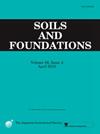Geostatistical-learning-based site-optimum 3D integration of borehole logs and geophysical data in urban area in South Korea
IF 3.3
2区 工程技术
Q2 ENGINEERING, GEOLOGICAL
引用次数: 0
Abstract
Success in civil engineering projects fundamentally depends on thoroughly understanding the site-specific subsurface characteristics. Site investigation, a critical process in the early stages of construction and design, serves as the foundation for ensuring the safety and efficiency of structural development and safeguards against potential disasters. However, owing to financial and time constraints, the number of site investigations is often limited, making spatial uncertainty one of the most significant challenges in geotechnical engineering. Geostatistics-based spatial interpolation techniques are widely used to overcome the limitations of spatial variability and information scarcity in geotechnical engineering. Reliable geospatial analysis is essential for identifying site-specific subsurface stratification information. In this study, site investigation data were collected at a subway construction site at which subsidence occurred during tunnel excavation. Borehole data were optimized using outlier removal to maximize reliability, and geophysical data were digitized to create a 3D integrated database with borehole data. Considering the subsurface characteristics, the optimal stratigraphic boundary elevations were determined using seismic wave velocities values, which clarified the optimized stratigraphic boundaries. Using kriging and simulation-based integrated analysis techniques, the subsurface stratigraphic information was predicted in 3D, and the cross-sectional and longitudinal geotechnical profiles confirmed that the layers with the least deviation effectively reflect the actual strata, which is consistent with the evaluation results, through a learning process that seeks the optimal method and parameters that produce the least prediction residuals. This approach highlights the importance of integrating advanced geostatistical-learning-based integration and geotechnical engineering practices to improve the accuracy and reliability of subsurface evaluations, thereby ensuring safer and more efficient construction.
在韩国城市地区,基于地质统计学习的井眼测井和地球物理数据的最佳现场三维集成
土木工程项目的成功从根本上取决于对特定场地的地下特征的彻底了解。现场调查是施工和设计早期阶段的一个关键过程,是确保结构开发安全和效率以及防范潜在灾害的基础。然而,由于资金和时间的限制,现场调查的数量往往有限,使得空间不确定性成为岩土工程中最重大的挑战之一。基于地质统计学的空间插值技术被广泛应用于岩土工程中,以克服空间变异性和信息稀缺性的局限性。可靠的地理空间分析对于确定特定地点的地下分层信息至关重要。本研究以某地铁施工现场为研究对象,在隧道开挖过程中发生了沉降。井眼数据通过去除异常值来优化,以最大限度地提高可靠性,并将地球物理数据数字化,以创建井眼数据的三维集成数据库。结合地下特征,利用地震波速度值确定了最佳地层边界标高,明确了最佳地层边界。利用克里格和基于模拟的综合分析技术,对地下地层信息进行了三维预测,通过寻找预测残差最小的最优方法和参数的学习过程,通过剖面和纵向岩土剖面证实,偏移最小的层段有效反映了实际地层,与评价结果一致。这种方法强调了将先进的基于地质统计学习的集成与岩土工程实践相结合的重要性,以提高地下评估的准确性和可靠性,从而确保更安全、更高效的施工。
本文章由计算机程序翻译,如有差异,请以英文原文为准。
求助全文
约1分钟内获得全文
求助全文
来源期刊

Soils and Foundations
工程技术-地球科学综合
CiteScore
6.40
自引率
8.10%
发文量
99
审稿时长
5 months
期刊介绍:
Soils and Foundations is one of the leading journals in the field of soil mechanics and geotechnical engineering. It is the official journal of the Japanese Geotechnical Society (JGS)., The journal publishes a variety of original research paper, technical reports, technical notes, as well as the state-of-the-art reports upon invitation by the Editor, in the fields of soil and rock mechanics, geotechnical engineering, and environmental geotechnics. Since the publication of Volume 1, No.1 issue in June 1960, Soils and Foundations will celebrate the 60th anniversary in the year of 2020.
Soils and Foundations welcomes theoretical as well as practical work associated with the aforementioned field(s). Case studies that describe the original and interdisciplinary work applicable to geotechnical engineering are particularly encouraged. Discussions to each of the published articles are also welcomed in order to provide an avenue in which opinions of peers may be fed back or exchanged. In providing latest expertise on a specific topic, one issue out of six per year on average was allocated to include selected papers from the International Symposia which were held in Japan as well as overseas.
 求助内容:
求助内容: 应助结果提醒方式:
应助结果提醒方式:


